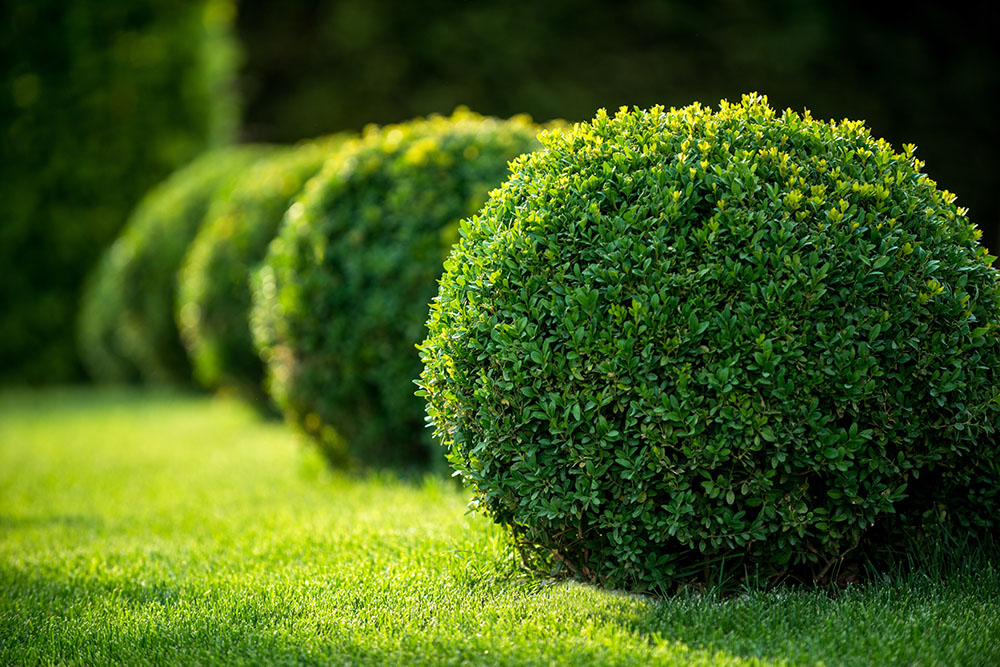SHOULD WE BE RECOMMENDING PLANTING BOXWOODS IN OUR LANDSCAPE?
Should we be planting boxwoods knowing that boxwood blight is prevalent in Central Virginia? My answer to customers who ask this question is YES, but with a different mindset when choosing boxwood varieties. There is no question that people need to be concerned about boxwood blight and how it has killed so many of our beloved boxwood plants these past few years. I’ll get into what boxwood blight is later in this blog. But, over the past few years, the nursery industry has been introducing so many beautiful and wonderful boxwood varieties that have been tested and found to be highly resistant to blight.
When I started working for The Great Big Greenhouse in the late 1970s (yes, I am old), we carried 3 basic types of boxwoods—American, English, and, on a lesser note, Korean. That was it—three varieties. Boxwoods were a Virginia staple when it came to plants in the landscape. Everyone who wanted boxwoods would plant English or American—depending on the area. Seeing these majestic beauties in the landscape was a landscape tradition. Unfortunately, with the boxwood blight, the English and American boxwoods are the most vulnerable and are on the decline in today’s landscape.
I’ll try not to be too technical in helping you understand boxwood blight. Boxwood blight has been killing boxwoods in Europe at an alarming rate, whereby these beautiful estate gardens are left with dead English and American boxwoods. This fungus was first discovered in North America in 2011. It was first found in Virginia in 2018, including Richmond and all the surrounding counties. With boxwoods, the first detection is on the leaves, causing circular, tan leaf spots, often with a darker border. Then black stem lesions appear on the new growth stems. Most homeowners do not detect a problem with their boxwoods until there is a severe leaf drop. The boxwood blight can quickly spread on the clothes that we wear, our shoes, our gardening tools, and leaves blowing from one area to another. If your boxwood plants have been inspected and diagnosed with blight, then it is suggested that you dig up the plants, put them in a garbage bag, and dispose of them.
Now, let’s look at the bright side. The nursery industry has been developing new varieties of boxwoods that are highly resistant to blight. We here at The Great Big Greenhouse pride ourselves on carrying many of these new varieties. NEW GEN BOXWOOD varieties are touted as “The New Approach for the American Classic.” These new varieties of boxwoods offer a better tolerance of boxwood blight and better resistance to the boxwood leafminer.
Another variety of boxwood that is highly resistant to blight is LITTLE MISSY. This is a personal favorite of mine. I know the family that developed this new boxwood, and I know Missy, who it was named after. Little Missy is a slow-growing, low mounding, with a beautiful growing habit, and is very cold and sun tolerant. This past month, Norm and Missy Cole visited France, where the country has been active in replacing blight-affected boxwoods with Little Missy. Norm and Missy were personally able to see their boxwoods planted in many of these majestic gardens in France. Lastly, Little Missy is an excellent boxwood to grow in decorative containers.
We have prided ourselves on our extensive selection of boxwood varieties for many years. It takes many different nursery growers to supply us with our needed inventory. We are pleased to inform you that each of our growers is very conscientious of the blight issue. They all participate in the Boxwood Blight Cleanliness Program to assure us that we are selling boxwoods that have been inspected regularly and found to be free of the boxwood blight.
HAPPY GARDENING & PLANT A LITTLE HAPPINESS WITH BOXWOODS!!!!!!!!!!!!!!

